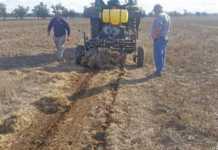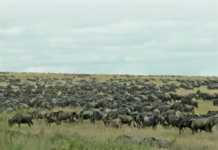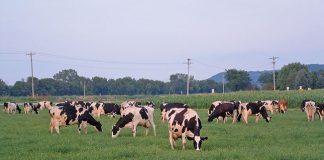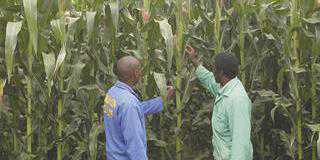Sub-Saharan African agriculture is in a crisis. Declining yields, impoverished soils and massive soil erosion are common problems in rural areas. Peter Hittersay attended the FAO Emergency Operations and Rehabilitation Division’s recent two-day regional conservation agriculture (CA) workshop, and reports on the urgent change in agricultural practices required and the CA solutions mooted.
According to a synopsis of Conservation agriculture: A manual for farmers and extension workers in Africa published by the International Institute of Rural Reconstruction of Nairobi and the African Conservation Tillage Network of Harare, distributed on a CD and brochure at the workshop, rice yields in West Africa have dropped significantly. Some 20% to 30% of sub-Saharan Africa’s cropland is now severely degraded, and the proportion is rising. Rural families are highly vulnerable to even minor distortions in weather patterns; increasing numbers of people are being driven out of the countryside because they can no longer feed themselves; and in too many countries relief aid is now more the norm than the exception.
The Food and Agricultural Organisation (FAO) of the United Nations estimates that 64% of Africans have agriculture as their primary source of income and livelihood. The World Bank predicts that the number of people living in absolute poverty in Africa will increase by 25%, from 315 million in 1999 to 404 million in 2015. Population pressure and poverty force most African farmers to cultivate only small plots of land. They scrape a living from overexploited soils, relying on their own labour and limited water supplies. Faced with acute labour shortages, and unable to buy equipment and fuel, they produce little surplus for sale.
The problem has two main sources. The first is impoverished soil resulting from intensive digging with hand hoes or ploughing that has exhausted soil organic matter and devastated soil structure, reducing its ability to hold moisture, and cut the amount of nutrients to critical levels. The second is labour shortages, as families decimated and weakened by HIV/Aids and malaria can no longer farm enough land to grow the food they need. Many have lost their draft animals to disease or have sold them to pay for medicine or food. Discouraged by the dismal prospects of farming, young people are deserting the land and flocking to the overcrowded cities.
Is conservation agriculture the solution?
Conservation agriculture (CA) may be a solution to both these problems. It can enable farmers to grow more food, using less labour, and at lower costs. By not exposing soil organic matter to the elements, soil fertility increases, and water-holding capacity improves over time. CA can improve the livelihoods of millions of people and achieve sustainable agriculture over a wide area. Ademir Calegari, soil scientist of Brazil’s Parana Institute of Agriculture, and John Ashburner, FAO specialist in conservation agriculture, summarises it in their co-authored paper Some experiences with conservation agriculture in Africa presented at the third World Congress on Conservation Agriculture in Nairobi in October 2005, “The full benefits of CA may take a number of years to achieve. However, dramatic results can occur after the first or second season, particularly if the soil is degraded and with poor fertility.”
CA is not a farming technology or practice. Rather, it is a method of farming based on three principles: Minimal soil disturbance. Instead of ploughing, farmers can plant their seed directly into the soil. They can do this using a simple hoe, or with inexpensive equipment such as jab planters or animal-drawn direct seeders. This improves the soil structure and enables the soil to retain more moisture, even during dry periods resulting in improved drought tolerance. Almost as important, no-till planting eliminates the enormous amount of time and effort small-scale farmers need to plough.
Soil coverage. It’s important to keep the soil covered with crop residues or with a cover crop. This protects the soil from erosion, adds organic matter and fixes nitrogen. It converts lifeless soil into healthy, living, fertile soil. The soil cover suppresses weeds – so less work is needed to remove them and keeps the soil cool. Trials in Mozambique comparing soil temperatures at 2pm at 2cm deep showed 43°C for bare soil and 30°C for mulched soil.
Rotate/mix crops. Instead of planting maize year on year, farmers should sow different crops in rotation or as intercrops. This raises fertility, enhances protection against pest and disease outbreaks, and provides food crops for a more varied diet – both for the farmers and their families, and for the microorganisms necessary for healthy soils. Overall, CA leads to more stable production and increased yields over time. None of these principles are new. What is new is that all should be applied at the same time to get the best results.
Other advantages are that CA spreads the manual labour needs throughout the year and increases labour productivity. Farmers can produce more food on a sustainable basis, save on labour and fuel, and have more time to cultivate a larger area or to engage in other income-generating activities. CA is especially attractive for women as it reduces the amount of work they traditionally do in land preparation and weeding. For families affected by HIV/Aids, CA offers a way to grow a diversified diet using limited labour. “However,” says Josef Kienzle, agroindustries officer of FAO, Rome, “It should not be forgotten that CA practices and related adequate equipment and input supply are only the ‘means’ to strengthen livelihoods through the envisaged improved food security, and increased resilience against climatic impacts.
The other aspect is farmer ownership and empowerment. Farmers and field extension workers need to be in the driving seat in adopting and adaptating CA to local circumstances and habits. It should not be seen as a ‘magic’ blueprint approach.”
African initiatives
CA is already practised on a large scale on millions of hectares in North and South America, and elsewhere in the world – latest estimates of the area under notill globally exceed 100 million hectares, plus the possibility of a further 25 million hectares in China. It has helped halt erosion, raise productivity, reduce the cost per unit produced and has contributed significantly to the production of soya beans, maize, beans and other crops in these countries. It has spread in Africa, and is being promoted in many countries, including Burkina Faso, Cameroon, Chad, Eritrea, Ghana, Kenya, Lesotho, Madagascar, Malawi, Mozambique, Namibia, South Africa, Swaziland, Tanzania, Uganda and Zambia, many of which have been supported on the ground through FAO’s regional emergency and rehabilitation programme.
In Kenya and Tanzania, a CA programme is assessing CA with small-scale farmers and vulnerable households in eight sub-humid and semi-arid districts. This programme is implemented by FAO and supported by the German government. It contributes to the UN’s initiative on Sustainable Agriculture and Rural Development. In Zambia’s Southern Province, CA has helped vulnerable households survive drought and livestock epidemics. Over 100 000 farmers in Zambia are said to now practise CA on at least parts of their farms. In the 2000/01 drought, farmers who used CA managed to harvest a crop, while those who used conventional methods faced total crop failure. After seeing the phenomenal gains in yield and reduction in soil erosion, Lesotho’s Ministry of Agriculture has adopted CA as official policy.
In Ghana, over 350 000 farmers now use CA on a wide range of crops, including maize, cocoyams and bananas. Some farmers have doubled or even tripled their grain yields after switching to CA. Projects have shown that CA is suitable for small-scale farmers as well as mechanised farms. It is particularly suited to vulnerable households and those headed by women. However, in his keynote paper coauthored with Jose Benites of FAO, entitled Situation of Conservation Agriculture in the World, presented at the World C onference on Conservation Agriculture in Iguassu, Brazil, in August 2003, Rolf Derpsch, possibly the most respected CA consultant in the world, said, “It is estimated that CA will grow at a much smaller rate in smallholder farming systems than in mechanised farms. The most important reasons for this are that too little research and development, as well as extension efforts, are being made for this target group. Another important reason is the logistics of how to reach a great number of small farmers in remote regions, with shrinking budgets for extension services.
While mass media strategies can work well with medium and big farmers, individual assistance over a period of time is necessary with small-scale subsistence farmers.” African farmers will remain the continent’s main food producers for a long time to come. They must grow at least two tons of food per hectare if the continent is to achieve the Millennium Development Goal of halving the number of malnourished and hungry by 2015. Nepad sees farming as Africa’s engine for growth. CA offers a real prospect of achieving this goal.
Government and donor agency support
However, to succeed CA will need strong support from governments and donor agencies. CA can be promoted through the existing extension service, but this needs to be reoriented, of which effective approaches include farmer field schools, community groups, training, local field days and exchange visits. Farmers need assistance to adapt CA principles to their particular situations. Research must be field-oriented, with farmers on their own farms. Wholesalers, local dealers, artisans and manufacturers require training and support to provide the implements, seed and other inputs needed. Rural finance schemes should encourage farmers and entrepreneurs to adopt CA. Policy support is vital to motivate farmers to change their current practices. Governments must avoid contradictory messages such as promoting ploughs at the same time as supporting CA, and school and university curricula must be revised. For more information visit the African Conservation Tillage Network at http://www.act.org/ FAO www.fao.org/ag/ca and International Institute of Rural Reconstruction www.iirr.org.
CA in South Africa
South Africans at the recent FAO Regional Conservation Agriculture Workshop felt strongly that immediate action was needed in the country if the workshop initiative was not to be lost and the agricultural potential of SA was to be saved. “There are a number of areas in our country where there is simply no soil left, and these are growing daily,” noted Richard Fowler, currently working with CA initiatives in the Eastern Cape, Lesotho and Swaziland. In an attempt to link farmers, advisers, input suppliers, researchers and policy-makers it was agreed that an informal network be established. To this end an e-newsletter and forum are being initiated, as well as an advisory service for those encountering specific problems or wanting to know more about the system. For more information e-mail Richard Fowler at [email protected].













